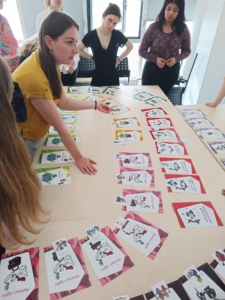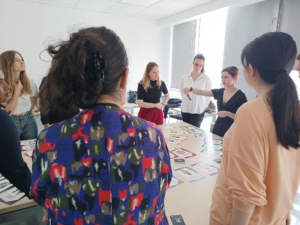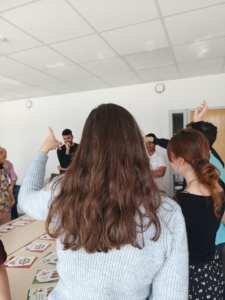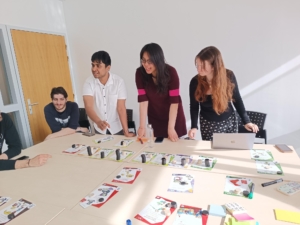- Home
- >
- THINK AND ORGANIZE ITS COURSE
- >
- Pedagogical activities and resources
- >
- Utiliser un jeu de cartes pour enseigner la Responsabilité sociétale...
Since the deployment of a relevant CSR action plan is not an exact science because it depends on the context, its implementation often appears complex and uncertain to learners. The term is used everywhere in communications to prove organisations’ commitment, but its use can often be akin to window-dressing promises that do not in fact address sustainable development in organisations’ core activities. However, an international standard,ISO 26000, has brought together more than 90 countries to definethe scope of CSR. This article sets out a fun and interactive teaching approach that facilitates the fair and sincere adoption of CSR in organisations via the ISO 26000 standard. The programme was rolled out to students on the CVO (chief value officerMaster’s programme in April 2023 and to students in the Managing for Sustainable for Impact Master’s programme at Audencia in May 2023.
Following on from this, we met Christophe Gotteland, a CSR consultant with whom Audencia has worked. Christophe’s corporate experience encouraged him to create a method for running discovery and training workshops based on a card game that enables participants to understand, , put into perspective and formulate proposals covering the spectrum of CSR, in line with the norme ISO 26000. For the first time, this game has been specially adapted for purely educational use.
Based on active teaching methods, the session lasts a minimum of 2 hours, but can be extended to 4 hours if additional content is added during the session, which also has the advantage of setting the pace of the workshop. Gathered around an island of tables where the cards are placed, the learners take it in turns to explore the themes of the norm (phase 1),the appropriateness of the actions undertaken in a given business in the light of its challenges (phase 2) and the performance achieved (phase 3). They will need to move around, , experiment, , bet on the importance of the principles that make up the 7 central questions of the standard(10 black tokens) and the level of performance (10 white tokens), and come to an agreement.The experience was very dynamic when witnessed; some learners organised votes using a show of hands to decide on definitions of terms that could be interpreted differently. At the end of the workshop, one student commented that he was pleasantly surprised that his classmates had spoken up when they usually remain silent in class. This is also part of the objective: to encourage debate, , to get involved,, to learn from others so that learning is better assimilated. Two students pointed out to me that the success of the workshop also depended on the how the teaching had been planned consistently in advance.To properly assess a company’s CSR performance during the workshop, the students had the opportunity to visitOLGA,interview employees and consult their extra-financial reports. This meant that they were placed in a real-life situation instead of the traditional presentation of a whole series of slides presenting the ISO 26000 standard. It’s a no-brainer!
A few recommendations to ensure a successful experience:
- Get to grips with a company case study beforehand, so as to be able to draw on concrete examples.
- As a teacher, ensure you are familiar with ISO 26000 so you can enrich the discussions, and give preference to Master’s level students with previous corporate experience (if you have no previous CSR experience, plan a long workshop).
- Plan for groups of 12 to 15 people maximum (in our case, the large groups were split into two to facilitate participative workshops)
- Include theoretical contributions throughout the workshop to reinforce the learning (make sure you keep the format interactive)
- Allow sufficient time for feedback so the teacher can resume the task in hand.
- Gather several tables in the centre to spread out the cards and spread out the chairs
- Minimum duration: 2 hrs 30 + allow 15 minutes before and after to prepare the room and put it away.
To finish, use the suggested scenario (contact the pôle learning & teaching Audencia) but be creative, as there are many possible variations. Don’t hesitate to get in touch with the teachers involved in this project: Sandrine Stervinou, Amélie Ruellan and Cathy Masson, Audencia lecturer.
Audencia equipment: 3 game sets in English, 2 game sets in French, 400 chips (200 black and 200 white)











